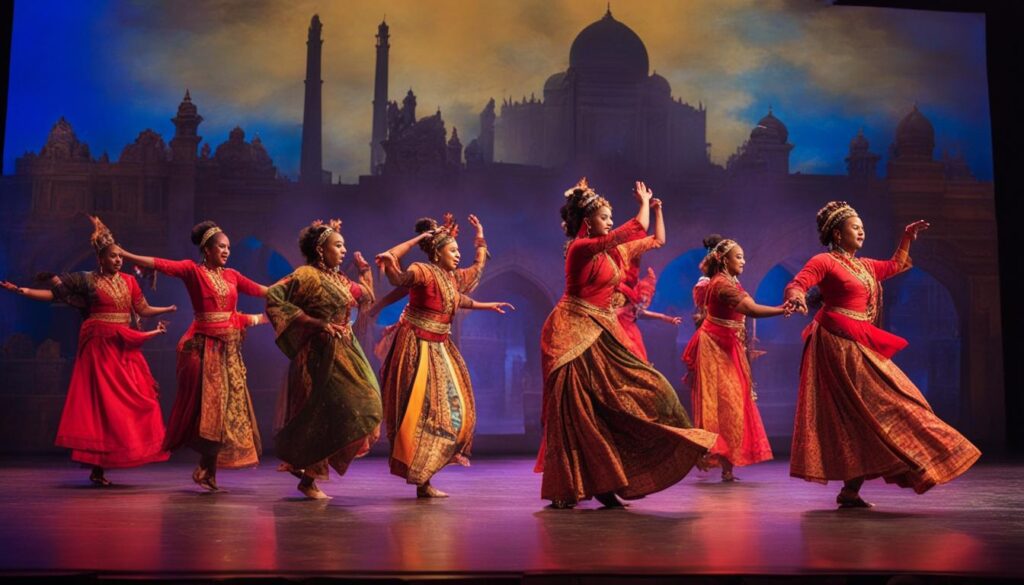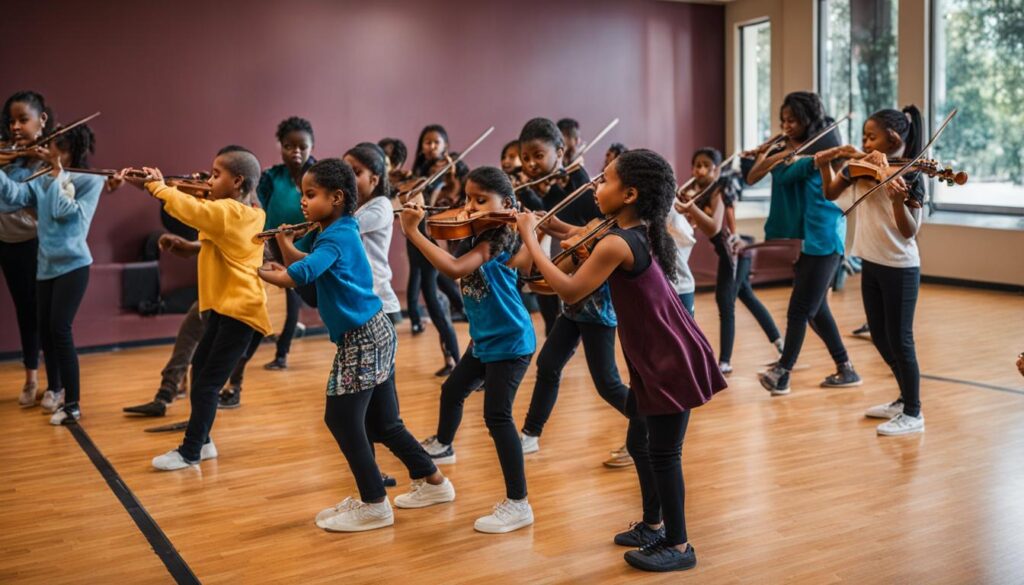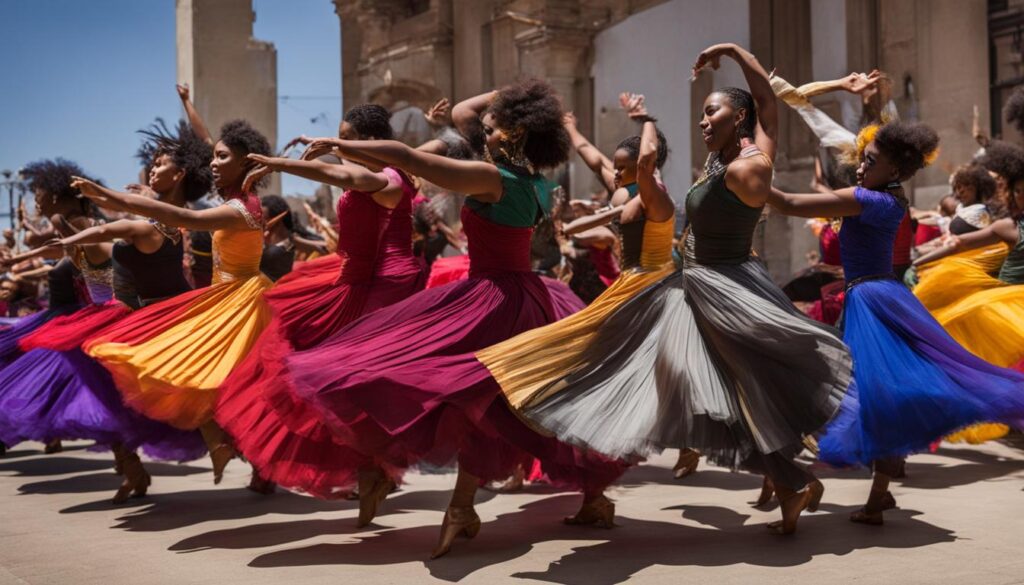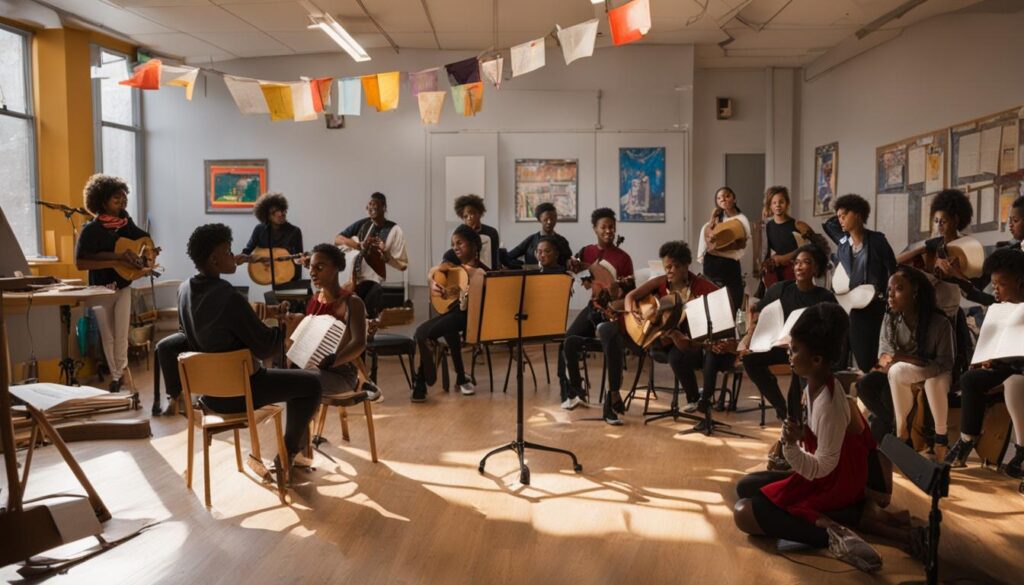Performing arts hold immense value and significance in our society. They play a vital role in self-discovery, expression, education, and cultural preservation. Through various art forms like music, dance, and theater, individuals are able to communicate, gain confidence, and explore their creative potential. The performing arts are not only a means of entertainment but also a pathway to personal growth and societal enrichment.
Why is Performing Arts Important
- The performing arts provide individuals with a platform for self-expression, communication, and confidence-building.
- Engaging in the performing arts promotes personal growth and creativity.
- Performing arts education plays a crucial role in developing skills like teamwork, empathy, and discipline.
- Performing arts serve as a reflection of culture and contribute to the preservation of cultural heritage.
- Supporting and investing in performing arts has both economic and social benefits for society.
The Impact of Performing Arts on Education
Performing arts education plays a crucial role in a comprehensive educational system. It provides students with a unique avenue for personal development and fosters essential skills and qualities that are beneficial throughout their lives.
One of the significant benefits of including performing arts in education is the development of teamwork and collaboration skills. Through group rehearsals and performances, students learn to work together towards a common goal, respecting and valuing each other’s contributions and strengths.
Moreover, the performing arts nurture empathy and the ability to understand and relate to others’ perspectives and experiences. As students engage with diverse stories and characters, they develop a deep sense of empathy and compassion, essential qualities for building strong relationships and fostering a supportive community.
The performing arts also contribute to building confidence and resilience in students. Sharing their talents and creativity with an audience helps them overcome stage fright, become comfortable with public speaking, and learn how to handle constructive criticism gracefully.
Additionally, participating in performing arts requires discipline, dedication, and determination. Students learn the importance of practice, perseverance, and the pursuit of excellence. These qualities not only enhance their artistic abilities but also transfer to other areas of their life, such as academics and personal goals.
Furthermore, the performing arts provide a creative outlet for self-expression. They encourage students to explore their emotions, thoughts, and ideas through various art forms, fostering creativity and fostering imagination. This outlet is especially important in the modern education system, which often emphasizes standardized testing and academic performance.
The inclusion of performing arts in education is essential for holistic development, nurturing students’ artistic talents, fostering personal growth, and cultivating essential skills for success in the twenty-first century.
The Cultural Significance of Performing Arts
Performing arts hold immense cultural significance as they serve as a reflection of society, capturing the very essence of a community’s history, traditions, and values. Traditional music, dance, and theater are cultural expressions that contribute to the intangible cultural heritage of a society. These art forms not only entertain but also educate, enlighten, and unite individuals by showcasing the rich diversity and creativity of human civilization.
However, the relevance of performing arts in modern society is facing several challenges. Standardization and the commodification of traditional art forms pose a threat to the authenticity and uniqueness of many performing arts. As a result, there is a pressing need to preserve, revitalize, and safeguard these art forms for future generations.
The Threat of Standardization and Commodification
Performing arts are at risk of losing their cultural significance due to the influence of globalization and the homogenization of artistic expressions. The standardization of performances and the focus on commercial success often overlook the intrinsic value and cultural context that performing arts bring.
Moreover, the commodification of traditional art forms for commercial gain can dilute their authenticity and lead to a loss of their true cultural significance. When art is treated solely as a product to be marketed and sold, it may lose its original purpose and become detached from its cultural roots.
Preserving and Revitalizing Performing Arts
To ensure the long-term viability of performing arts, cultural promotion and awareness play a crucial role. Emphasizing the cultural significance of these art forms can help create a demand for authentic and culturally rooted performances. This requires educating audiences about the historical, social, and cultural contexts that shape these arts, fostering an appreciation for their unique qualities.


Cultural institutions, festivals, and community organizations also have an important role to play in preserving and reviving performing arts. By providing platforms for artists to showcase their talents and facilitating cultural exchange, these organizations help ensure the continued vitality and relevance of performing arts in modern society.
Overall, recognizing and nurturing the cultural significance of performing arts is crucial in preserving our collective heritage, promoting diversity, and fostering a sense of identity and belonging. It is through the celebration and preservation of performing arts that societies can thrive and maintain their cultural richness for generations to come.
The Personal Growth and Well-Being Benefits of Performing Arts
Engaging in the performing arts offers numerous benefits to individuals, both in terms of personal growth and overall well-being. Whether it’s through theater, dance, or music, participating in the performing arts has transformative effects on individuals’ lives.
1. Self-expression and Confidence
Performing arts provide a platform for individuals to express themselves freely. Whether it’s through acting, dancing, or singing, performers have the opportunity to showcase their unique talents and abilities. This self-expression not only boosts confidence but also helps individuals embrace their true selves.
2. Emotional Outlet and Resilience
The performing arts serve as a safe space for individuals to cope with their emotions and release stress. Through artistic expression, individuals can explore and channel their feelings, finding solace and catharsis. This emotional outlet enhances resilience and helps individuals navigate life’s challenges.
3. Sense of Identity and Belonging
Participating in the performing arts allows individuals to develop a sense of identity and belonging. By immersing themselves in the artistic world, performers connect with like-minded individuals who share their passion. This sense of community fosters a supportive environment, encouraging personal growth and self-discovery.
4. Life Skills Development
The performing arts provide a unique opportunity for individuals to develop essential life skills. Whether it’s discipline, determination, teamwork, or the ability to handle constructive criticism, performers learn valuable lessons that extend beyond the stage. These skills are transferable to various aspects of life, contributing to personal and professional success.
5. Joy and Inspiration
The joy and inspiration derived from engaging in the performing arts are immeasurable. Whether as a performer or an audience member, the beauty and creativity displayed on stage uplift spirits and ignite passion. The performing arts have the power to inspire individuals to pursue their dreams, think outside the box, and appreciate the beauty of human expression.
By participating in the performing arts, individuals experience personal growth, enhance their well-being, and gain valuable life skills. The benefits of engaging in the performing arts extend far beyond the stage, creating a positive impact on individuals’ lives and society as a whole.
The Economic and Social Impact of Performing Arts
The performing arts have a profound impact on both the economy and society as a whole. Their influence extends beyond entertainment, contributing to the cultural and economic vitality of communities. One of the key benefits of supporting performing arts is their ability to attract cultural tourists, generating revenue and supporting local economies. Cultural tourism is driven by individuals seeking unique experiences related to music, dance, theater, and other performing arts forms.
Performing arts festivals, concerts, and theatrical productions act as magnets for visitors, encouraging them to explore new destinations and interact with local culture. As a result, hotels, restaurants, retail stores, and other businesses thrive, creating job opportunities and stimulating economic growth. The performing arts sector also boosts employment through the hiring of artists, producers, technicians, and support staff.
Beyond their economic impact, performing arts play a vital role in social development. They foster community engagement, inclusivity, and social cohesion by providing platforms for dialogue, connection, and understanding. Through performances, individuals from diverse backgrounds come together, sharing a common experience that transcends societal divisions. The performing arts promote empathy, encouraging people to view the world through different perspectives.
Reasons to Support Performing Arts
- Performing arts enhance the quality of life in communities, making them more vibrant and culturally rich.
- They attract visitors, driving tourism and supporting local economies.
- Performing arts contribute to social development by fostering inclusivity, community engagement, and dialogue.
- They promote empathy and understanding, bridging societal divisions.
- The arts provide a creative outlet, supporting individual expression and well-being.
- Investing in performing arts helps develop talent and nurture artistic skills.
By providing financial and institutional support to the performing arts, communities can reap the economic and social benefits they offer. Cultural organizations, governments, and individuals all have a role to play in ensuring the continued growth and sustainability of this vital sector.


Supporting and investing in performing arts is not only an investment in creativity and self-expression but also a commitment to the overall well-being and vibrancy of society. The economic impact drives local economies, and the social impact fosters community engagement, inclusivity, and empathy. By recognizing the value of performing arts and supporting their continued growth, we can create a society that thrives culturally, socially, and economically.
Preserving and Safeguarding Performing Arts
In order to safeguard the performing arts and ensure their continued existence, a multi-faceted approach is required. Preservation efforts encompass various measures aimed at transmitting knowledge and techniques while strengthening the bond between master and apprentice. This ensures the survival of traditional art forms that have been passed down through generations.
Research, documentation, archiving, and digitization of performances are crucial for preserving the invaluable cultural heritage associated with performing arts. By capturing and preserving these artistic expressions, we can ensure that they are accessible to future generations and continue to inspire and educate.
Cultural media, institutions, and industries play a vital role in raising awareness about the importance of preserving performing arts. They contribute to the development of audiences by creating platforms for artists to showcase their work and promoting connoisseurship among the public.
Efforts to preserve and safeguard performing arts also require improvements in training and infrastructure. Providing adequate resources and support for artists, venues, and organizations is essential to ensure their sustained growth and development.
Promoting Preservation Through Technology
Technology plays a crucial role in the preservation of performing arts. By leveraging digital platforms and innovative tools, we can reach wider audiences and ensure the longevity of performances. Online archives and streaming platforms allow people from around the world to engage with and appreciate various forms of performing arts.
Moreover, virtual reality (VR) and augmented reality (AR) technologies enable immersive experiences that bring performances to life in new and exciting ways. These technological advancements not only enhance preservation efforts but also provide opportunities for exploration and learning.
Fostering Collaboration and Partnerships
Preserving performing arts requires collaboration and partnerships between artists, cultural institutions, government agencies, and the public. By working together, we can pool resources, share knowledge, and create a collective impact. Collaboration also helps to bridge gaps in funding and expertise, ensuring a more comprehensive approach to preservation.
Furthermore, engaging local communities and involving them in preservation efforts is crucial. By creating a sense of ownership and pride, communities become advocates for their cultural heritage, actively contributing to its preservation and safeguarding.
Conclusion
The performing arts have a profound impact on individuals and society as a whole. They are not only important for personal growth and cultural preservation but also contribute to education, social development, and economic prosperity.
Through the performing arts, individuals are able to express themselves, build confidence, and unleash their creativity. It provides them with a platform to explore their emotions, thoughts, and identities. Moreover, performing arts education equips students with important skills like teamwork, discipline, and resilience, which are crucial for their holistic development.
Beyond personal growth, performing arts also educate us about our history, culture, and society. They serve as a powerful tool for fostering empathy, understanding, and social cohesion. By experiencing different art forms, we gain insights into different perspectives and cultivate a sense of appreciation for diversity.
The impact of performing arts extends beyond the individual and has economic benefits as well. They contribute to the growth of cultural tourism, supporting local economies and creating job opportunities. Moreover, the performing arts bring people together, foster community engagement, and promote dialogue, thus enriching the overall fabric of society.
Given the multidimensional impact of performing arts on individuals and society, it is imperative that we recognize their significance. By appreciating and supporting the performing arts, we ensure their continued vitality and preserve their role in human development, cultural heritage, and societal enrichment.
FAQ
Why are performing arts important?
Performing arts play a vital role in self-expression, communication, and personal growth. They also educate us about history and culture, foster creativity, and contribute to societal enrichment.
What impact do performing arts have on education?
Performing arts in education help develop essential skills such as teamwork, empathy, and creative thinking. They also build confidence, teach discipline, and encourage students to express themselves creatively.
What is the cultural significance of performing arts?
Performing arts reflect a community’s history, traditions, and values, contributing to cultural preservation and heritage. They also serve as a reflection of modern society, promoting dialogue and inclusivity.
How do performing arts enhance personal growth and well-being?
Engaging in performing arts promotes self-expression, confidence, resilience, and emotional well-being. They provide a creative outlet for individuals to cope with emotions and develop important life skills.
What is the economic and social impact of performing arts?
Performing arts contribute to the economy through cultural tourism and the generation of revenue. They also foster social development by promoting community engagement, inclusivity, and social cohesion.
How can performing arts be preserved and safeguarded?
Preserving performing arts requires measures such as knowledge transmission, research, documentation, archiving, and improvements in training and infrastructure. Cultural media and institutions also play a crucial role.
Why do performing arts matter?
Performing arts are important for personal growth, cultural preservation, education, social development, and economic prosperity. They provide individuals with self-expression, creativity, and an understanding of history, culture, and society.

